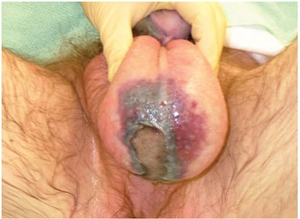We need you! Join our contributor community and become a WikEM editor through our open and transparent promotion process.
Fournier gangrene
From WikEM
Contents
Background
- Life-threatening polymicrobial necrotizing fasciitis of perineum, genitalia, or perianal area.
- Mostly bacteria lower GI system - B. fragilis and E. coli
- Obliterative endarteritis of subcutaneous arterioles leads to gangrene of overlying skin[1]
- Mortality - often cited as 20-40%, but up to 80% in some studies[2]
Risk Factors
- Diabetes mellitus (most common)
- Hypertension
- Alcoholism
- Advanced age
- Para/Quadriplegic
- Males>Females (10:1)[1], (likely under-diagnosed in women[2])
Clinical Features
- Initial event is usually local trauma or extension of a UTI or perianal infection[1]
- Gangrene develops over 2-7 days
- Marked pain, localized swelling, crepitus, ecchymosis to genital or perineal area.
- Fever
- Malodorous purulent drainage
- In late or severe cases, patient may present in septic shock
Differential Diagnosis
Testicular Diagnoses
- Testicular torsion
- Epididymitis
- Orchitis
- Torsion of testicular appendage
- Scrotal abscess
- Fournier gangrene
- Hydrocele
- Indirect inguinal hernia
- Hematocele
- Spermatocele
- Testicular trauma
- Testicular rupture
- Varicocele
- Inguinal lymph node (Lymphadenitis)
- Testicular tumor
- Cellulitis
- Tinea cruris
Evaluation
Work-up
- CBC - very elevated leukocytosis
- CMP - hyponatremia
- ESR
- CRP
- Lactate
- Type and Screen
- Wound Culture
- Blood Cultures
- CT Abdomen/pelvis (only if diagnosis unclear or if requested by surgery/urology)
Evaluation
- Clinical diagnosis, based on history and physical exam
- LRINEC score here: Necrotizing fasciitis
Management
- Immediate surgery and urology consult for surgical debridement (gangrene can spread at rate of 2-3 cm/hr[1])
- Antibiotics - Must cover gram positive, gram negative, and anaerobes
- Vancomycin + (imipenem 1gm IV q24hr OR meropenem 500mg-1gm IV q8hr)
- Aggressive supportive care, including fluid resuscitation (and pressors, if indicated)
Disposition
- Admit to ICU

